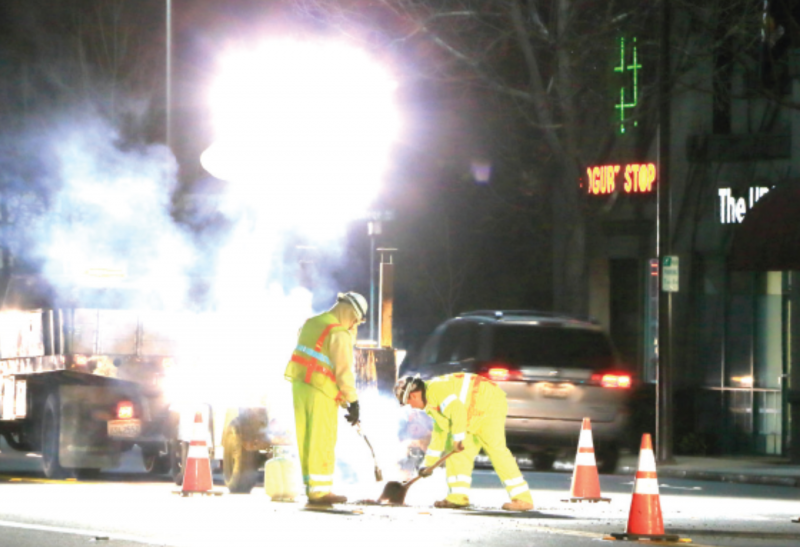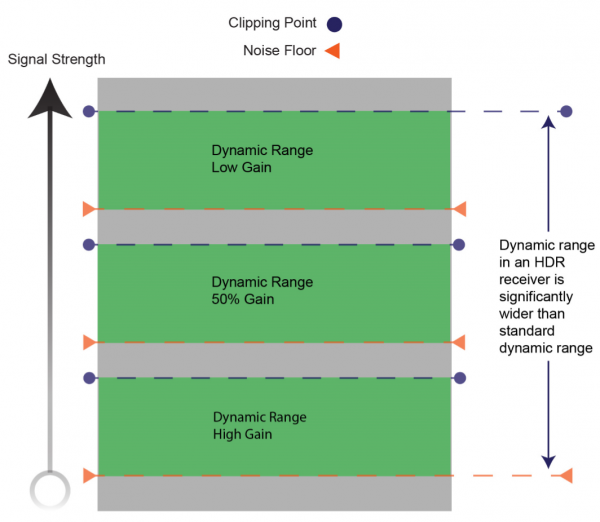Understanding Gain and High-Dynamic Range Locating
In utility locating (and in life in general), we are comfortable with what we know. Utility locating is a difficult and under-appreciated trade, and with so many uncertainties in the field, it’s critical that the people on the ground are confident and capable with their locating equipment. By the same token, what is familiar to us today shouldn’t stop us from continuing to work towards better solutions for tomorrow, as the demand for utility locating in our crowded underground network continues to grow.
Fig. 1: At one end of the dynamic range is the noise floor. Below it, a signal is indistinguishable from noise. The upper boundary of the dynamic range is the clipping point. Signals that are above the clipping point are distorted and reduced to the maximum level the receiver can trace. Either scenario jeopardizes locating accuracy.
On Gain: What It Is and Why We Have It
One technology that many operators are carefully trained to use is the locating receiver’s gain adjustment. Gain is, essentially, receiver sensitivity. How the gain is set on your receiver determines the range of signal levels it can detect. Understanding why gain exists and how to manipulate it is crucial for operators who use gain-adjustable receivers, since misunderstanding gain can seriously compromise locate accuracy.
Why do most receivers give you the ability to adjust gain, and why is it so important to teach operators how to use it? Here’s why: a receiver can only detect signals that are within its dynamic range. Dynamic range is the ratio of the strongest signal to the weakest signal that a receiver can process.
It’s a reality of the job that some signals are much stronger or weaker than others. To account for the variety of signal levels that are encountered in the field, operators need some method to ensure that they can trace strong and weak signals alike.
Modifying gain lets you move your receiver’s dynamic range up or down. For the first-time user, it can be a little counterintuitive. Keeping your gain low shifts the dynamic range of your receiver up, letting you trace stronger signals. Adjusting your gain higher moves your receiver’s dynamic range down, letting your receiver detect weaker signals that might otherwise have been too noisy to trace. We usually give operators some version of the following guideline for their workflow: keep gain low for most signals, and increase it only when it seems like the signal is too weak to trace.
Perhaps the most important thing to know about gain is that modifying gain makes any signal appear stronger or weaker than it actually is. Gain doesn’t change the signal, it modifies how the receiver processes it, which can affect our perception of how strong the signal is. (To actually change signal strength, adjust transmitter power or improve grounding conditions.) This is one of the reasons why it’s so critical for operators to understand what gain really is and how to use it carefully.
Receivers with automatic gain control (AGC) entered the market promising a more user-friendly experience for locating operators. Instead of requiring operators to manually adjust gain to fit the locate, the receiver’s software determines which gain setting is best-suited for the immediate locate conditions and adjusts it accordingly. The semi-automatic gain option controls gain automatically, but lets operators manually intervene and reset gain when necessary. While user experience and preferences can differ, the science is the same. Whether gain is adjusted by the receiver itself or a human hand, the effect is that some signals are traceable and others are not.
Expanding Dynamic Range
There’s another technology that addresses the need to locate a variety of signal levels. Advancements in digital signal processing broaden the dynamic range of a utility locating receiver —about three times as wide as the dynamic range on a gain-adjustable receiver. With this technology, a receiver with a high-dynamic range (HDR) can detect very strong and very weak signals at the same time.
Because there is no method for the operator to control gain, they are sometimes assumed to be AGC receivers. But the technology behind HDR receiving is an entirely different animal from gain. Neither technology is “right” or “wrong,” and operators should use equipment that they feel comfortable using. But because they work so differently—and frankly, because HDR locating is newer and not as well-known—it’s important to know how those differences play out.
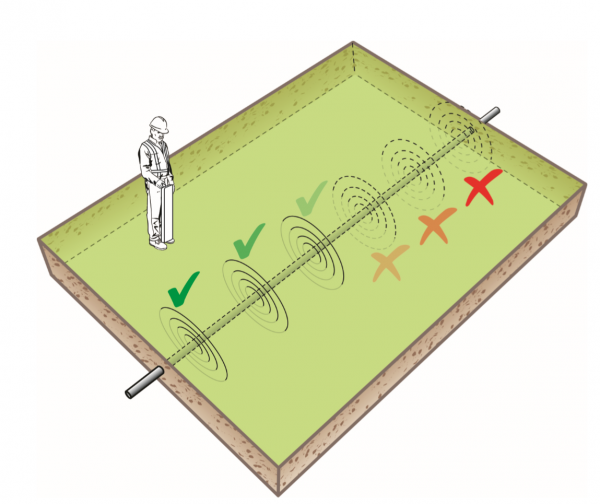
Fig. 2: Keeping your gain low allows you to trace stronger signals, but weaker signals are too noisy to trace.
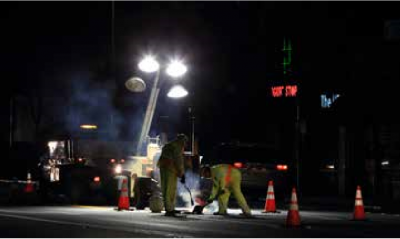
Fig. 4 – Mid-Level Gain: Some dark areas and bright spots can be seen, but the picture is dark overall. Turning the gain down results in an even darker picture with only the lights visible.
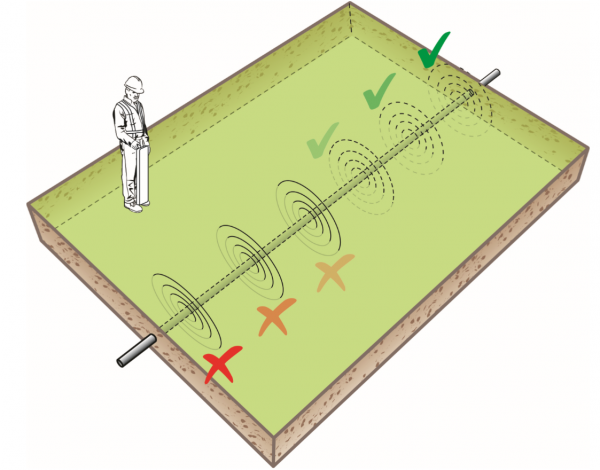
Fig. 3: Keeping your gain set high can allow you to trace weaker signals. Stronger signals are clipped.
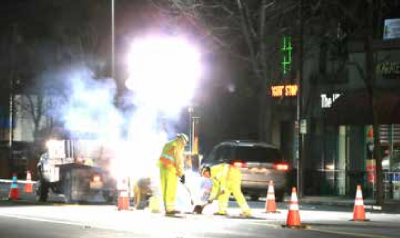
Fig. 5 – High-Level Gain: Darker areas are seen better than before, but bright spots are clipped and detail is lost.
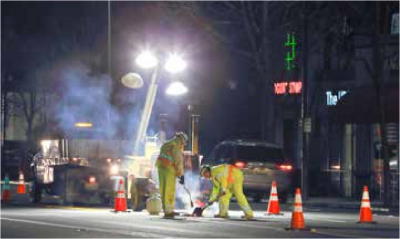
Fig. 6 – High-dynamic range captures bright spots and dark areas without clipping lights or leaving out detail.
Adjusting Gain on a Digital Camera
To put this all in visual terms, consider another device that has a dynamic range: the digital camera. Imagine you’re walking through a city at night and notice a crew doing utility work in the road. You take a photo, but when you look at it, the workers and the surrounding area are too dark to make out much detail. You increase the exposure—your “gain” setting on the camera—hoping that allowing more light in the camera lens will let you see the scene more clearly. In the second photo, the workers appear in much better detail. However, the lights are blown out, washing out any detail in nearby objects.
Capturing the extreme differences between light and dark objects without overexposing or underexposing the photo is a common obstacle for pho-tographers. The poor results in the roadwork photo can be attributed to the dynamic range of the camera. In photography, the dynamic range is the ratio of the brightest highlights to the darkest shadows that can be captured in a photo. If the dynamic range is too narrow in a given lighting situation, the areas that are too light or too dark are adjusted to levels that the camera can process, resulting in a loss of detail.
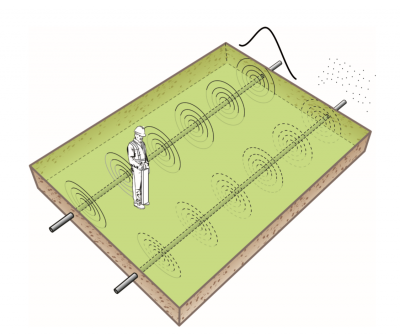
Fig. 7: Consider this example: an operator is tracing a gas line. With the gain kept low, the operator walks down the line and marks the utility. Meanwhile, the electrical current bleeds off the line into the soil. The current must return to the transmitter, so it couples onto an adjacent water pipe to return to the transmitter. The operator passes over the water pipe on his way back to the transmitter. However, because the gain is still low, the much weaker signal on the water pipe looks like noise.
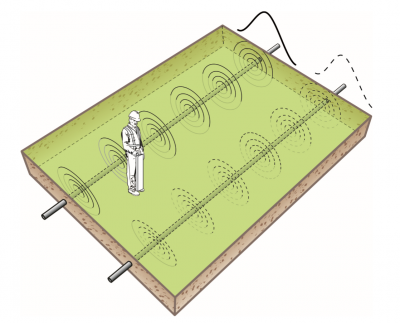
Fig. 8 – Mid-Level Gain: Since walking over other utilities during a locate is almost a given, and since the maps we have aren’t always accurate, it’s critical that operators are able to see and distinguish these other potentially unknown utilities. An HDR receiver can see the clear peak on the water service, alerting the operator that another utility is there.
HDR Photography and Locating
Changing the camera’s exposure is similar to adjusting gain on a locating device. Adjusting exposure prioritizes shadows or highlights, but not both at once. Likewise, adjusting gain, either manually or with AGC, can show you strong signals or weak signals, but not at the same time.
HDR locating in essence achieves the same thing as an HDR camera. HDR signal processing significantly expands the dynamic range on a receiver, allowing it to detect both stronger and weaker signals without making any adjustments. Since operators must work with changing signal levels, an HDR receiver can give them a leg-up in the field by showing when these signal changes occur. Furthermore, being able to see dramatic changes in signal levels can help operators distinguish multiple utilities in the area— an important ability given how many utilities are buried underground.
Noisy Background, or Another Utility?
In photography, there are instances when you don’t want to see every de-tail, such as a silhouette at sunset. There’s a comparison to be made here with utility locating. For many years, the industry has generally taught that keeping gain low and increasing it only when necessary helps the operator “home in” on the target utility. If the goal is to see one utility at a time, gain helps operators do just that, and has done so for decades.
HDR locating in essence achieves the same thing as an HDR camera. HDR signal processing significantly expands the dynamic range on a receiver, allowing it to detect both stronger and weaker signals without making any adjustments. Since operators must work with changing signal levels, an HDR receiver can give them a leg-up in the field by showing when these signal changes occur. Furthermore, being able to see dramatic changes in signal levels can help operators distinguish multiple utilities in the area— an important ability given how many utilities are buried underground.
However, the underground network of pipes and cables is crowded and getting more so by the day. In increasingly congested right-of-ways, it is no longer enough to follow a single target utility as it weaves above and below other utilities. We need technology that can do some of the work for us to detect multiple utilities without having to energize each utility one at a time.
Looking Ahead
For operators who use a gain-adjustable receiver, understanding what gain is and why it works is a necessary skill. Knowing how to control gain keeps operators on-target, minimizing the chances of mis-marking a line. But it isn’t the only way to handle the variety of signal levels that operators must trace in the field. And as more utilities are buried underground, we need to think of ways to maximize our chances of finding everything in the area of an excavation project—not just the utilities we think are there. This applies regardless of what equipment we choose to use.
High-dynamic range receivers offer a way to see changing signal levels quickly and without modification. With our expanding underground infrastructure, it’s time for our equipment to detect and analyze those “distracting” signals in the background for us. HDR helps us do that, but there’s always more we can do. Once our locating technology catches up to what modern software is capable of doing, we’ll have the tools to capture the data that’s necessary to compile truly innovative and accurate information on utilities—for projects now and many years to come.


